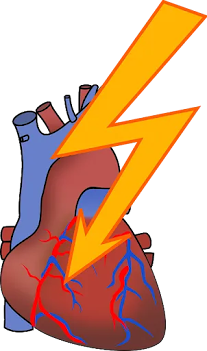MEDICAL EMERGENCY- CARDIAC ARREST AND BASIC LIFE SUPPORT
Definition:
"Cardiac Arrest is a medical emergency requiring a systematic approach".
- Early recognition must be followed by prompt, effective application of Basic Life Support (BLS) techniques to sustain the patient until Advanced Life Support (ALS) capabilities are available.
Management:
The management of Cardiac Arrest is a 4-step approach:
- Recognition and Assessment
- BLS
- Advanced Cardiovascular Life Support (ACLS)
- Post-resuscitation Care
1. RECOGNITION AND ASSESMENT
Verify that the respiration and circulation have ceased:
- Loss of consciousness
- Loss of functional ventilation (respiratory arrest or inadequate respiratory effort)
- Loss of functional perfusion (No pulse).
2. BASIC LIFE SUUPORT (BLS)
- The goal in cardiac arrest is the restoration of spontaneous circulation (ROSC).
- The first step towards achieving this ROSC goal is prompt initiation of BLS, where the goal is to rapidly and effectively perfuse the tissues with oxygenated blood. A delay in initiating BLS or providing ineffective BLS can result in Irreversible hypoxic (not enough oxygen to the tissues) brain injury.
- Summon help and resuscitation equipment.
- Establish adequate airway.
- Provide rescue breathing by delivering two slow, deep breaths. Ventilate by mouth-to mouth, mouth-to mask, or bag-valve-mask techniques.
- Check for pulse and other signs of circulation. When available, assess heart rhythm with an automated external defibrillator or Monophasic/Biphasic defibrillator.
- If ventricular tachycardia or ventricular fibrillation are documented, defibrillate with 200 joules of direct current shock.
- If the first shock fails to terminate the dysrhythmia, a second shock with 200-300 joules should be attempted. if the first two shocks fail, shock again with 360 Joules.
5. Reassess cardiac rhythm and check for a pulse. If no pulse or other signs of circulation are present, initiate rescue breathing and Chest compressions.
- For Rescue breathing:
Deliver 1-12 breaths per minute or 1 breath every 4-5 seconds.
- For External Chest compression:
Position patient supine on a firm surface.
Ensure proper placement of your hands on sternum.
Depress sternum at a rate of 80-100 cycles per minute (50% of cycle should be compression).
For every 15 chest compressions, give 2 breaths.

Comments
Post a Comment